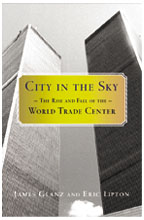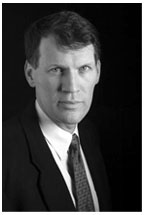James Glanz *91 scrutinizes the towers’ design and construction. (Photo: Fred Conrad) |
March 24, 2004: Reading Room
America’s
brash icon
James Glanz *91 traces the birth and demise of the W.T.C.
By Louis Jacobson ’92
On the morning of September 11, 2001, New York Times science reporter James Glanz *91 was eating breakfast with his wife. Their television was silent, but Glanz’s mother suddenly called from Des Moines, to tell them that a plane had just flown into the World Trade Center. Glanz raced downtown to the Times’s newsroom. “As I shot past the science editors’ pod,” Glanz recalls, “the deputy science editor pointed to me,” and said a single word: “Structure.”
For more than two years, Glanz has tried to figure out why the Twin Towers fell — a job that led to the publication last November of City in the Sky: The Rise and Fall of the World Trade Center (Times Books). A biography and autopsy of the towers, the book begins in the 1960s, with the bitter struggle between the powerful Port Authority of New York and New Jersey and a scrappy bunch of small-business owners whose shops stood in the way of “progress.” The book continues with the challenge of designing and building the massive towers.
 Glanz
and his coauthor, Times reporter Eric Lipton, scrutinize every
aspect of the complex’s design and construction, and then record,
in painful detail, what happened to the towers and the people inside on
the day of the attacks. Many Americans had some aspect of September 11
that they couldn’t get out of their minds, says Glanz, who earned
a doctorate in astrophysical sciences and joined the Times staff
full-time in 1999. “For me, it was thinking about the people above
the zones of impact. What happened to them while the building was dying
from within?”
Glanz
and his coauthor, Times reporter Eric Lipton, scrutinize every
aspect of the complex’s design and construction, and then record,
in painful detail, what happened to the towers and the people inside on
the day of the attacks. Many Americans had some aspect of September 11
that they couldn’t get out of their minds, says Glanz, who earned
a doctorate in astrophysical sciences and joined the Times staff
full-time in 1999. “For me, it was thinking about the people above
the zones of impact. What happened to them while the building was dying
from within?”
Although the cause of the collapse is still under investigation by a federally convened panel, Glanz and Lipton examined evidence that the Twin Towers’ fate on September 11 was determined by the decisions made decades earlier by the Port Authority. The designers built floors largely devoid of internal columns; the towers’ structural integrity relied instead on a lightweight latticework incorporated into the buildings’ facades and a tight palisade of columns in the buildings’ center cores. This innovative design helped the buildings withstand the initial impacts of the hijacked jumbo jets, rather than toppling instantly. But the Port Authority’s decision to spray the towers’ metalwork with only a small amount of foamy fire retardant seems to have doomed the towers to eventual collapse, the authors write. Even worse, Glanz and Lipton say, the fireproofing decision was made arbitrarily, in secret, and without oversight by city fire officials, who lacked jurisdiction over the Port Authority.
While researching the book, the authors spent many days in the subterranean
reaches of Ground Zero — a disturbing place that Glanz worries may
not be reflected in the airy, light-filled proposals for memorials. “It’s
a ruin. They pulled twisted steel and bones out of there,” he says.
Visiting the collapsed wreckage, he says, was like visiting a “battlefield.
. . . You walk into that zone, and the rest of the city fades away.”
![]()
Louis Jacobson ’92 is a staff correspondent at National Journal magazine.
BOOK SHORTS
 Washington’s
Crossing — DAVID HACKETT FISCHER ’57 (Oxford). In
his account of General George Washington’s Christmas-night crossing
of the Delaware River to surprise exhausted Hessian forces at Trenton
in 1776, the author compares British and American battle strategies and
discusses key battles before and after the crossing. Fischer also examines
figures such as General Horatio Gates and Lord Cornwallis, and describes
attacks on the British by American guerrillas. Fischer, a historian, is
University Professor at Brandeis University.
Washington’s
Crossing — DAVID HACKETT FISCHER ’57 (Oxford). In
his account of General George Washington’s Christmas-night crossing
of the Delaware River to surprise exhausted Hessian forces at Trenton
in 1776, the author compares British and American battle strategies and
discusses key battles before and after the crossing. Fischer also examines
figures such as General Horatio Gates and Lord Cornwallis, and describes
attacks on the British by American guerrillas. Fischer, a historian, is
University Professor at Brandeis University.
 All Right
Let Them Come: The Civil War Diary of an East Tennessee Confederate
— edited by CHARLES SWIFT NORTHEN III ’59 (Tennessee). This
diary of John G. Earnest, who en-listed in the 60th Tennessee Infantry
in September 1862 and was Northen’s great-grandfather, details the
daily activities of a low-ranking officer, describes what he sees as the
weaknesses of the Confederate army, and records his involvement in the
siege of Vicksburg. Northen is a retired investment manager in Alabama.
All Right
Let Them Come: The Civil War Diary of an East Tennessee Confederate
— edited by CHARLES SWIFT NORTHEN III ’59 (Tennessee). This
diary of John G. Earnest, who en-listed in the 60th Tennessee Infantry
in September 1862 and was Northen’s great-grandfather, details the
daily activities of a low-ranking officer, describes what he sees as the
weaknesses of the Confederate army, and records his involvement in the
siege of Vicksburg. Northen is a retired investment manager in Alabama.
 Mortal Secrets:
Truth and Lies in the Age of AIDS — ROBERT KLITZMAN ’80
and Ronald Bayer (Johns Hopkins). In this book Klitzman, a psychiatrist,
and Bayer, an ethicist, explore how people infected with H.I.V. decide
whether to tell others about their illness. Based on more than 70 interviews,
the book examines the moral, social, and psychological decisions involved
in H.I.V. disclosure and looks at public-policy questions about disclosure.
Klitzman and Bayer are professors at Columbia University.
Mortal Secrets:
Truth and Lies in the Age of AIDS — ROBERT KLITZMAN ’80
and Ronald Bayer (Johns Hopkins). In this book Klitzman, a psychiatrist,
and Bayer, an ethicist, explore how people infected with H.I.V. decide
whether to tell others about their illness. Based on more than 70 interviews,
the book examines the moral, social, and psychological decisions involved
in H.I.V. disclosure and looks at public-policy questions about disclosure.
Klitzman and Bayer are professors at Columbia University. ![]()
By Lucia S. Smith ’04

